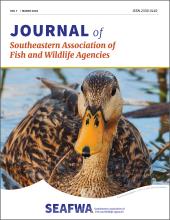Interannual Variability in Spatial and Temporal Spawning Distributions of White Bass in the Arkansas River
There is a limited understanding of the spatial and temporal variability of tributary use for riverine populations of white bass (Morone chrysops) during the spawning season. We sampled white bass in 10 tributaries of Arkansas River Pool 4 during their spawning season in 2010 and 2011. Each tributary was sampled using boat-mounted electrofishing every third week during the spawning season to assess spatial variability of white bass spawning. One tributary (Caney Bayou) known to be occupied by white bass during the spawning season was sampled weekly to document temporal variability of the...
